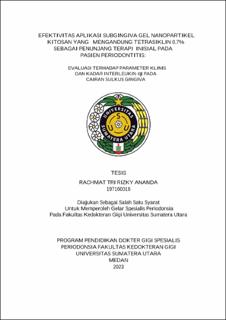Efektivitas Aplikasi Subgingiva Gel Nanopartikel Kitosan yang Mengandung Tetrasiklin 0.7% sebagai Penunjang Terapi Inisial pada Pasien Periodontitis: Evaluasi terhadap Parameter Klinis dan Kadar Interleukin-1β pada Cairan Sulkus Gingiva
Effectiveness of Subgingival Application of Chitosan Nanoparticle Gel Containing 0.7% Tetracycline as an Initial Therapy Support in Periodontitis Patients: Evaluation of Clinical Parameters and Interleukin-1β Levels in Gingival Culcus Fluid

Date
2023Author
Ananda, Rachmat Tri Rizky
Advisor(s)
Ervina, Irma
Agusnar, Harry
Metadata
Show full item recordAbstract
Introduction: The main cause of periodontitis is bacterial plaque. Bacteria that penetrate into the periodontal tissue will interact with the host response. The interaction between bacteria and host response will secrete proinflammatory cytokines such as IL-1β. The use of tetracycline in periodontal support therapy showed a significant improvement in pocket depth and a decrease in the number of bacterial colonies. Chitosan as a natural polymer material has good biodegradability, good drug delivery system, non-toxicity, anti-bacterial effect, anti- inflammatory effect, and good biocompatibility. Gel Chitosan nanoparticles have advantages in terms of slower and controlled drug release, better drug solubility and stability, and lower toxicity.
Objective: This study aims to analyze the improvement of periodontal conditions clinically and analyze changes in IL-1β levels in gingival sulcus fluid as well as the correlation between clinical parameters and IL-1β levels after scaling-root planing with the application of chitosan nanoparticles loaded 0.7% tetracycline as supporting initial therapy in periodontitis patients. Methods: The study samples were non-contiguous molar I/II teeth with socket depth ≥ 6 mm whose gingival sulcus fluid was taken before SRP and 7 days after subgingival application of gel chitosan nanoparticles loaded 0.7% tetracycline. The study sample was divided into three groups: SRP group accompanied by subgingival application of chitosan nanoparticles loaded 0.7% tetracycline, SRP group accompanied by subgingival application of nanoparticles and SRP group only.
Results: The results of this study showed that there was an improvement in clinical parameters (PBI, PD, CAL and GI) and a significant decrease in IL-1β levels in the SRP group accompanied by subgingival application of gel chitosan nanoparticles loaded 0.7% tetracycline with statistically significant results (p<0.05). The test results using the Spearman correlation test showed that the clinical parameter that correlated significantly (p<0.05) with IL-1β levels was PD.
Conclusion: Subgingival application of gel chitosan nanoparticles loaded 0.7% tetracycline as supporting therapy is effective in improving clinical parameters (PBI, PD, CAL and GI) and reducing IL-1β levels.
Collections
- Master Theses [39]
